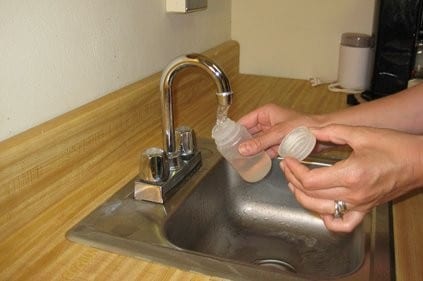
The Revised Total Coliform Rule (RTCR) requires all public water systems to have a Distribution System Sampling Plan (DSSP). A DSSP is your roadmap for routine water quality monitoring throughout the system. It outlines where and when you’ll take samples and what you’re sampling for — such as Total Coliform Bacteria, which are indicators of potential contamination. This plan should have enough detail on routine and repeat sampling procedures to enable any certified sampler or operator to accurately identify site locations and collect samples following established protocols. The sampling plan format and required information varies slightly by state. Before creating your sampling plan, visit your state agency’s water quality website and search “Revised Total Coliform Rule” for templates or guidance on your state’s requirements.
In general, the sampling plan includes:
- Public water system name and ID number
- Contact information
- Date
- Sample collection schedule
- List of all sampling locations with a description and maps if available. Includes physical addresses and which faucets were used.
- Instructions for collecting, preserving, and transporting samples. Also known as the standard operating procedure (SOP).
Selecting A Sampling Location
- Choose sites that reflect normal conditions across your system and space sampling locations throughout your entire system.
- Try to find the most sanitary faucet or sink. Never select a faucet with an aerator or a faucet that swivels or drips. These can introduce contaminates and skew results.
- Select locations with steady and frequent water use and avoid seasonal or vacant buildings unless there’s constant flow.
- Your sampling sites will likely require approval by your state agency. They may do this when reviewing your DSSP.
Preparing to Grab a Sample
- Take samples from the cold-water side of a faucet, never the hot water side.
- Use bottles, seals and chain of custody forms provided by a certified lab.
- Disinfect faucet with alcohol solution prior to sampling.
- Wash hands prior to grabbing sample or use gloves.
- Don’t touch the inside of the bottle or the cap.
- Never wash out the bottle. It is sterilized and contains sodium thiosulfate to neutralize chlorine residual.
- Always have extra bottles on hand just in case the bottle or lid is dropped or contaminated in any way with dirt or debris. It is better to use a new bottle if you are ever unsure.
- Bring a cooler and ice packs to store the samples in for transport to the lab.
Grabbing a Sample
- Turn on the faucet and flush for 3 to 5 minutes. This will ensure water is from the main line and not from plumbing under the sink. While faucet is flushing start to fill out the chain of custody form with the date and time of collection.
- If a chlorine residual test is required, do so while flushing and record on the chain of custody form. If residual is below 0.3 mg/L flushing of the main distribution line should be done prior to the next month’s sampling. Flushing the main distribution line will raise the chlorine residual.
- Lower the flow of faucet before grabbing the sample so no splashing occurs. Do not touch the inside of the cap or bottle. Fill the bottle slightly over the 100 ml line or as directed by the lab. If you do not collect enough water the lab could reject the sample.
- After sampling take the samples directly to the lab. If you cannot deliver immediately, you should keep the sample in the refrigerator between 1-4 °C. Samples usually must be received within 24-30 hours of collection. Your lab will specify.
- Try to take samples at the first of the week and first of the month in case a positive sample is reported and repeat samples are required. Do not take samples on Friday. Labs will reject them because the results need to be read within 24 hours, and most labs are closed on the weekends.
For more resources visit EPA’s Building the Capacity of Drinking Water Systems website or read EPA’s Quick Guide to Drinking Water Sample Collection.

